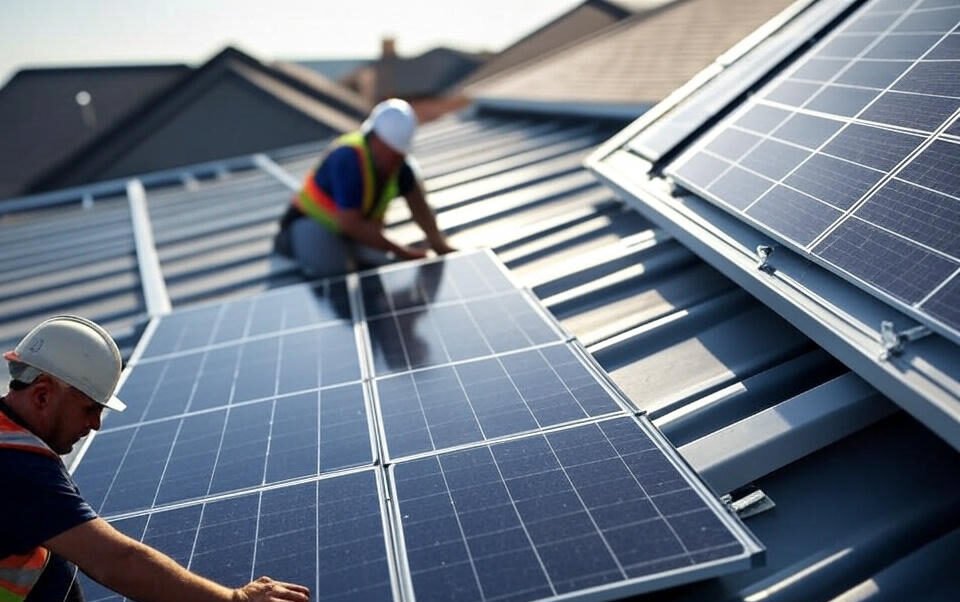Homeowners often wonder if they can install solar panels on a metal roof. The answer is yes. Metal roofs provide a strong and reliable surface for solar panel setups. This combination offers a practical way to save on energy costs while supporting a greener planet. Installing solar panels on a metal roof is not only possible but also highly effective due to the roof’s durability and design. We explores the advantages, types of metal roofs, installation process, key considerations, and common challenges. By the end, you will understand why this setup works and how to approach it.
Why Choose a Metal Roof for Solar Panels?
Metal roofs stand out as an excellent choice for solar panel installation. Their strength and long lifespan make them ideal for supporting solar systems. Unlike traditional asphalt roofs, metal roofs resist wear from weather, ensuring the panels stay secure for decades. This durability means homeowners avoid the hassle of replacing their roof during the solar panels’ lifespan. Additionally, metal roofs often use recycled materials, aligning with the eco-friendly nature of solar energy. Combining these two creates a sustainable home energy solution that lasts.
Durability That Lasts for Decades
A metal roof can last between 40 and 70 years, far outpacing the 25 to 30 years of a typical solar panel system. This extended lifespan ensures that once you install the panels, your roof remains reliable without needing costly repairs or replacements. The sturdy nature of metal also handles the weight of panels without requiring structural upgrades in most cases. Homeowners benefit from a setup that stays strong through storms, heavy snow, or intense heat.
Energy Efficiency Boost
Metal roofs reflect sunlight, which helps keep homes cooler in hot weather. When paired with solar panels, this cooling effect increases. The panels provide shade, reducing heat absorption even further. This synergy lowers your home’s cooling costs, especially in summer. By generating clean energy and cutting reliance on the grid, this setup reduces your carbon footprint. Homeowners see both environmental and financial benefits from this combination.
Cost Savings Over Time
Installing solar panels on a metal roof can lead to significant savings. While the initial cost varies, the long-term reduction in energy bills adds up. Many regions offer tax credits or incentives for solar installations, which help offset upfront expenses. A metal roof’s durability also means fewer maintenance costs compared to other roofing materials. Over time, the combination of lower energy bills and minimal roof upkeep makes this a smart financial choice.
Types of Metal Roofs for Solar Panels
Not all metal roofs are the same, and the type you have affects how installers attach solar panels. Each roof type requires a specific approach to ensure a secure and leak-free installation. Understanding your roof’s design helps you choose the right method and avoid potential issues.
Standing Seam Metal Roofs
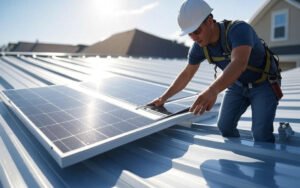
Standing seam roofs feature raised edges that create a sleek, modern look. These roofs are the easiest for solar panel installation. Installers use clamps that grip the seams without drilling holes. This method keeps the roof watertight and speeds up the process. The lack of drilling also preserves the roof’s warranty, making it a popular choice for homeowners. Standing seam roofs provide a clean and efficient foundation for solar systems.
Corrugated Metal Roofs
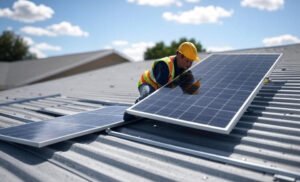
Corrugated metal roofs have a wavy or ribbed surface. Installing solar panels on this type requires drilling small holes for brackets. Installers place these brackets on the raised portions to avoid water pooling. They apply high-quality sealant to prevent leaks. While this method works well, it demands skilled professionals to ensure the roof remains watertight. Homeowners with corrugated roofs can still enjoy solar energy with proper installation.
Trapezoidal Metal Roofs
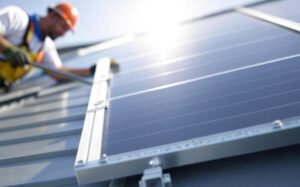
Trapezoidal roofs have flat-topped ridges, giving them a distinct shape. Installers attach brackets over these ridges, securing them with screws and sealant. The brackets are custom-fit to match the roof’s profile, ensuring a tight and stable connection. This approach prevents leaks and provides a strong base for the panels. Like corrugated roofs, trapezoidal roofs require careful work to maintain their integrity during installation.
Specialized Installation for Unique Designs
Some metal roofs have unique patterns or coatings that need special attention. For example, certain trapezoidal or corrugated roofs may use advanced sealants or custom brackets to accommodate their design. Installers assess the roof’s specific features to choose the best mounting system. This ensures the panels stay secure without compromising the roof’s appearance or function. Homeowners with custom metal roofs should consult experienced installers to handle these details.
How Solar Panels Are Installed on Metal Roofs
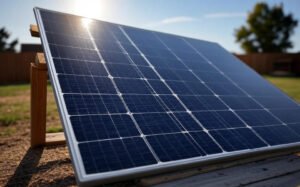
The installation process for solar panels on a metal roof follows a clear and structured approach. Professionals assess the roof, plan the layout, and use specialized tools to secure the panels. Each step ensures the system works efficiently and safely.
Assessing the Roof and Planning
Installers begin by inspecting the roof for any damage or weak spots. They check its age and condition to confirm it can support the panels. Next, they map out the panel placement to maximize sunlight exposure. South-facing areas typically work best for capturing solar energy. This planning stage ensures the system performs at its peak and avoids future issues.
Mounting the Panels
The mounting process depends on the roof type. For standing seam roofs, installers attach clamps directly to the raised seams. These clamps hold rails that support the panels. For corrugated or trapezoidal roofs, installers drill holes for brackets and apply sealant to prevent leaks. Rails are then fixed to the brackets, and the panels are clipped onto the rails. This creates a secure and stable structure for the solar system.
Connecting the System
After mounting, installers connect the panels to your home’s electrical system. They run wiring from the panels to an inverter, which converts solar energy into usable power. The system ties into your home’s grid, allowing you to use solar energy and draw from the utility when needed. Professionals ensure all connections meet local safety codes for reliable performance.
Key Considerations Before Installation
Before installing solar panels, homeowners must evaluate several factors. These considerations help ensure a smooth process and long-term success.
Roof Condition and Age
Check your roof’s age and condition. An older roof may need repairs or replacement before adding panels. Damaged areas, like rust or loose seams, must be fixed to avoid leaks or instability. A structural engineer can assess whether your roof can handle the added weight. Most metal roofs pass this test, but it’s wise to confirm.
Choosing a Qualified Installer
Hiring an experienced installer is critical. Look for professionals with a track record of working on metal roofs. Ask for references and compare quotes from multiple companies. A good installer offers warranties for both the work and the roof’s integrity. This protects you from potential issues like leaks or faulty setups.
Budget and Incentives
The cost of installing solar panels varies based on the system size and roof type. A small home might spend $10,000 to $20,000, but tax credits can reduce this amount. Research local and federal incentives to lower your upfront costs. Over time, savings on energy bills and potential increases in home value make the investment worthwhile.
Challenges and Solutions
While installing solar panels on a metal roof is straightforward, some challenges may arise. Knowing these issues and their fixes helps you prepare.
Preventing Leaks
Drilling holes in corrugated or trapezoidal roofs can lead to leaks if not done correctly. Skilled installers use high-quality sealants and place brackets carefully to avoid water damage. For standing seam roofs, clamps eliminate the need for holes, reducing this risk entirely. Always choose professionals who understand metal roof systems to prevent leaks.
Maintaining Roof Warranties
Some metal roof warranties may void if holes are drilled. Check with your roof manufacturer before installation. Using clamp-based systems on standing seam roofs avoids this issue. Discuss warranty details with your installer to ensure your roof remains protected.
Weather and Maintenance
Harsh weather, like strong winds or heavy snow, can stress solar panels. Properly installed mounts keep the system secure. Regular cleaning of the panels ensures they work efficiently. Dust or debris can reduce energy output, so schedule annual maintenance to keep your system in top shape.
Conclusion
Installing solar panels on a metal roof is a smart and practical choice. The roof’s durability, energy efficiency and long lifespan make it an ideal match for solar systems. Whether you have a standing seam, corrugated, or trapezoidal roof, professionals can install panels securely using the right techniques. By checking your roof’s condition, choosing skilled installers, and understanding costs, you set yourself up for success. This setup saves money, boosts your home’s value, and supports a cleaner planet. Start exploring your options today to enjoy the benefits of solar energy.
FAQs
Do solar panels damage metal roofs?
Solar panels do not damage metal roofs when installed correctly. Clamps or sealed brackets ensure a secure fit without harming the roof’s surface.
How much does installation cost?
Costs range from $10,000 to $20,000 for a typical home, depending on the system size. Tax incentives can lower this expense significantly.
Can I install panels on an old metal roof?
You can, but the roof must be in good condition. Repairs or reinforcement may be needed for older roofs to support the panels.
Do I need a professional installer?
Yes, professionals ensure safe and effective installation. They follow codes and protect your roof’s warranty, saving you from costly mistakes.






